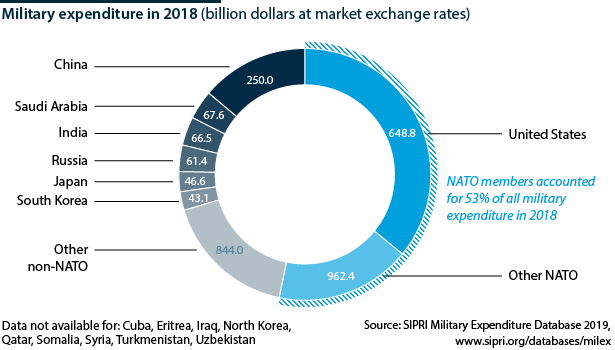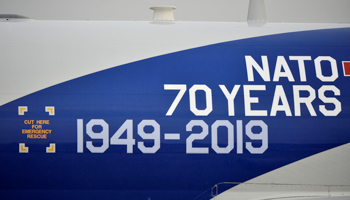Prospects for NATO in 2020-24
NATO’s next five years will see disharmony, growth, adaptation, modernisation and structural and technical strengthening
The shadow of recent internal differences may mar the 70th anniversary summit, but NATO’s political difficulties are superficial: the alliance is becoming more integrated and stronger operationally.
What next
NATO will invite North Macedonia to become its 30th member; further enlargement remains on the agenda. Russian sabre-rattling will ensure focus and discipline in an increasingly complicated environment of threats and challenges. More allies will meet the agreed 2% of GDP defence-spending target.
Strategic summary
- The allies will recognise space as a new domain of warfare, adding to cyber, introduced in the last decade.
- China will become an official concern for the first time.
- A new strategy addresses complicated security challenges, pairing new missions with such means as special forces and offensive cyber operations.
- NATO will both maintain its renewed core focus on collective defence against Russia and, despite some leaders’ wishes, intervene ‘out of area’.
Analysis
French President Emmanuel Macron has spurred intense discussion by declaring NATO "brain dead". He did so after Turkey's incursion into northern Syria, which followed US President Donald Trump's withdrawal of US special forces. Neither country informed its allies, including France and the United Kingdom, which had specialist teams on the ground (see SYRIA/TURKEY: Talks over ‘safe zone’ will drag on - September 6, 2019).
In addition, Trump's latest National Security Advisor, Robert O'Brien, has chastised Germany in particular for not paying its "fair share".
Trump, Turkey and turbulence
Running for president, Trump questioned the US commitment to protecting countries not doing enough to protect themselves. He even suggested the United States might leave NATO. Trump's statements were unrealistic but left allies concerned; at times, he has been strongly positive about the alliance.
Turkey is purchasing S-400 missiles from Russia, NATO's historical foe. In response, the United States has suspended Turkey from the F-35 fighter programme. Meeting in Washington, Trump and Turkish President Recep Tayyip Erdogan agreed to seek a 'solution' to the question of the S-400s, which become operational in April.
Despite the tension these steps have caused, they are unlikely to have critical effect. NATO's history is riven with differences that have been overcome. European allies have regarded Washington as unreliable before.
Disruptions will be navigated as neither Trump nor Erdogan will last forever
Burden-sharing
The burden-sharing issue is a long-standing US concern, irrespective of administration. Washington, which has overwhelmingly carried the burden so far, has always wanted its allies to spend more.
At the 2014 summit, each country committed to spending 2% of its GDP on defence. By 2019, only seven members met that commitment, although several are to achieve it by 2024/25, when NATO celebrates its 75th birthday.
That will still leave many not hitting the target until NATO turns 80, at least. However, patterns of defence expenditure have changed. The US share has fallen and the general trend has been for other allies' aggregate defence expenditure to rise (see GERMANY: Berlin will build up defences gradually - July 11, 2018).
Washington will continue to push its allies on spending
Facts on the ground
NATO is gaining strength structurally. Its increasingly integrated military structures, unparalleled in history, are its greatest asset.
US commitment
Despite Trump's rhetoric against multilateral relations, his administration has shown growing engagement with the alliance, a key instrument of power and influence for Washington.
- Spending on NATO has increased by 100 billion dollars.
- Mechanised units, withdrawn in 2013, are now back in strength, the number of permanently based personnel has grown by over 5% under Trump, the number of rotating forces under the European Defence Initiative (EDI) has grown and funding for it has doubled.
- The United States has led more alliance training exercises, particularly under the EDI, with the largest for 25 years scheduled for 2020.
- Washington has developed and continues to develop new technological systems for the alliance.
Structural shift to Europe?
Increased European expenditure on defence includes significant new initiatives.
- The EU's Permanent Structured Cooperation programme (see EU: Defence cooperation could make real progress - January 5, 2018) is advancing 25 joint innovative defence technology projects, although they will take time and almost certainly prove more expensive than budgeted.
- Germany has taken the lead in developing a more integrated and operationally ready approach to territorial defence in Europe under the 'Framework Nation Principle', whereby one large ally provides a core for others to plug into, vastly improving operational readiness. In 2023, it will take charge of the Very High Readiness Joint Task Force, having fully armed and built up three divisions and eight brigades that had been hollowed out.
- Germany's initiative is modelled on the UK Combined Joint Expeditionary Force (JEF), which focuses more on action outside the NATO area, but also within it. The JEF particularly facilitates cooperation with France and other countries, including some formally outside the alliance, such as Sweden.
- The 'Visegrad four' have formed the V4 Battlegroup, comprising the Czech Republic, Slovakia, Hungary and Poland, and Croatia has also joined. Ostensibly an EU initiative, the battlegroup regularly conducts exercises within the NATO Response Force.
This is a structural shift towards greater European capability, albeit limited and still leaving burden-sharing questions for countries with overlapping NATO and EU membership. The United States will remain the leading force in NATO. If the United Kingdom eventually leaves the EU, then the 20 EU NATO members together will only contribute around 20% of alliance defence spending, despite increasing their military budgets appreciably in the last five years.
Macron's comments indicate that even France, often 'different' and distant in the NATO context, sees clearly that such European developments, while strengthening aspects of EU defence, will necessarily remain primarily focused on the alliance. He recognises that stronger EU defence must be in NATO, even if with an overlap that can eventually help a separate EU defence capability.
Integrated systems
A sign of NATO's increasing strength concerns its integrated systems. These include the airborne early warning and command and control system (AWACS), a singular feature of the alliance, which has given it a significant and overarching advantage over any adversary for over 30 years.
NATO will commit to a 1-billion-dollar upgrade and modernisation of AWACS at the London summit, giving it and the alliance a new lease of life for decades ahead.
Baltic defence
NATO's defence of the Baltic states and Poland against any threat of Russian attack is another sign of its strength in practice. The presence of four multinational battlegroups, at high readiness and conducting rolling exercises, makes the prospect of a Russian attack less likely. It is also a strong symbol of NATO's commitment to its core mission.
Complexity and new strategy
Historically, the alliance could deal with one challenge at a time. Today, security challenges on the eastern and southern flanks, international terrorism, the new domains of cyber and space, and the rise of China require daily attention.
NATO must meet new the new security environment's rapidly evolving challenges
Unity in strength
If the new strategy gets fundamental thinking about the future right, the alliance will prosper and continue keeping Europe safe, while broadly protecting and promoting democratic values. The range of risks and challenges in the world make it inevitable for the allies to act.
Most of all, Russia's assertive and disruptive approach to international affairs is assisting NATO, ensuring that despite political disharmony, diversity adds up to unity and strength. Despite its differences, the alliance will celebrate its 2025 anniversary stronger than ever, as the strongest military force in history representing over half the world's defence capabilities quantitatively, amplified by exceptional qualitative advantages in almost every domain.



